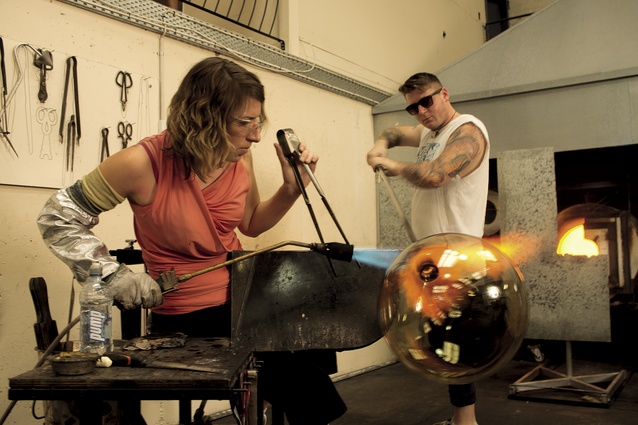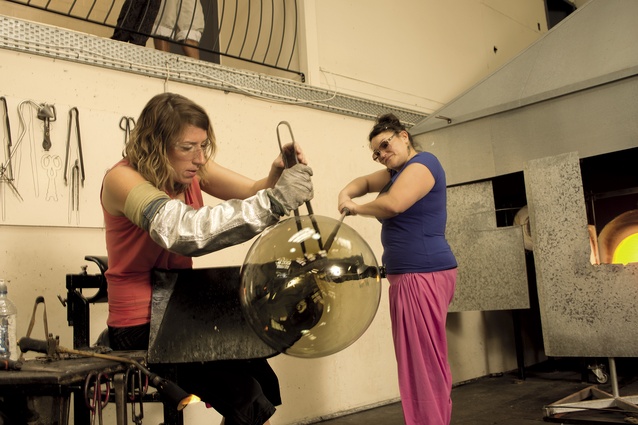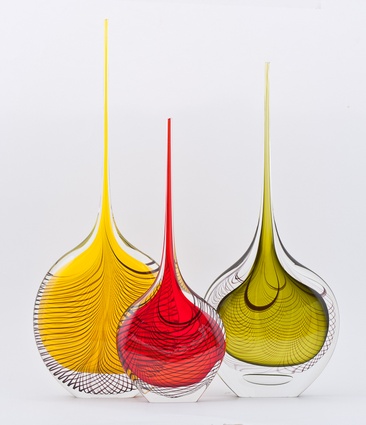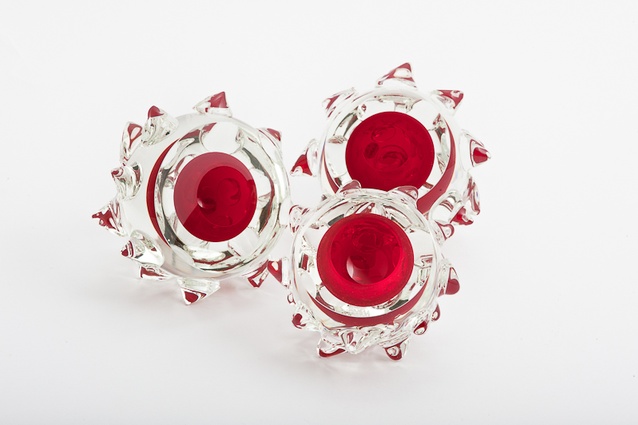Q&A: Katie Brown
Were you artistic or interested in design as a child? If so, what’s the first thing you designed or made…?
My mother Mandy Brown is an artist so I always had a mentor and someone to look up to. I started my first artistic project when I was nine, which was selling painted pet rocks at a local craft day. I thought it was great as I didn’t have to pay the overheads but took the profits. Every year after that there was some sort of project where I would sell my work. I learnt the combination of working hard and making money.
Glass blowing is a niche area and not something most people are exposed to. How did you get involved?
I was searching for an art form that would help me to be a full-time artist. I had always been intrigued with glass and was introduced to the medium by my brother Ewan Brown and his wife Judi Keith-Brown; they are both collectors of fine art and glass and inspired me to investigate the material further. Seeing the process, I knew I had found the medium I wanted to excel in. There’s no other process like it.
Where did you train?
Wanganui has the only glass-blowing school in New Zealand and because of this are about 40 glass artists here. I started the course in 1997, when it was the Wanganui Regional Polytechnic Glass School.
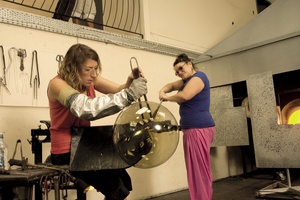
Do you travel to meet other artists to compare notes, and do you have any mentors in the field – or do you mentor those interested in learning?
I have always had a huge passion for travel and have combined this with my desire to meet some of the world’s master glass artists. After completing three years at the glass school I landed a job with renowned glass artist Josh Simpson, in Massachusetts, where I worked for three years. From there, I went to England and worked with many glassmakers, and I’ve also gone to various conferences and workshops to further my experience. The opportunities that I was given at the start of my career were such a crucial part of my journey that it’s really led me to want to support and mentor many up and coming glass artists. I mentor talented students coming through the glass school have also employed some in my business as a stepping-stone in their journey. I have been involved in the Wanganui Glass Group committee for the last five years and my current role as chairperson is to promote Wanganui as the glass centre of New Zealand and to provide the local community with visiting artists from around the world to share their energy and knowledge. I believe in giving back to the community.
What do you think attracted you to glass? Do you need to have a certain personality type to work with it?
I was attracted to the fluidity of glass, how it moves and the crazy things it can do… Glass definitely attracts certain people. Firstly, you need to be able to handle the heat, shed blood, sweat and tears, and generally have the determination to succeed with the material. Molten glass is like no other material I have ever worked with; it is hot, runny and wants to fall on the floor. It was the process that intrigued me the most; it is almost medieval and you get to use all sorts of interesting hand-crafted tools.
Can you give me an overview of the process, how many steps are involved, where do you source raw materials?
The furnace goes 24 hours a day at 1100°C and inside that is a crucible that holds 220 kilograms of molten glass. We source the glass material, which is a sand mixture called ‘batch’, from Australia. This is mostly made up of silica sand. We go through nine tons of glass a year. The process, depending on what you are making, starts with getting a hot ‘gather’ out of the furnace. To do this you use a large, heated blow pipe – you dip it into the molten glass and wind it up, a bit like a knife into golden syrup. Every form has a different process and it can be very technical when it comes to adding colour and making shapes. It is really the years of experience that dictate what is made. Sometimes there could be 50 steps in one piece and at each step a number of challenges could appear. I often think of myself as a surgeon in glass.
Do your techniques vary much from piece to piece – for instance, do you employ the same method to make a pendant as you do to make a vase?
I employ various techniques depending on the form I am making. For instance, there are hundreds of ways to add colour to your form and this is where the technical side comes in. In my work I use a lot of lines and to do this I pull long threads of coloured glass, this is like two people having a tug of war with molten glass. I use these threads a lot in my work, as I am very interested in line and how it moves with the piece.
What about colour, how or when is that added to the process?
Depending on which technique you are working with the colour can be added at a number of different points in the process. As a glass artist in New Zealand I feel very lucky to be able to source the colour from Gaffer Glass in Auckland, this is a homegrown company that is doing very well world wide. There are over 100 colours available from powders and grits to solid blocks. You spend your life learning how to apply these.
Do you have any preferred artists or designers, in any field?
Sad but true, I like to follow artists in glass. Most of the legends in glass are still alive and I feel blessed that I can get on a plane and go and do a workshop with them somewhere overseas. Lino Tagliapietra and Dante Marioni are two glassmakers that amaze me with their technical abilities.
Is there one of your pieces that was a real ‘aha’ moment, a time when you really felt like you’d nailed a technique, or developed a greater understanding of the medium?
There’s one piece I’ve named “Big Red”, and 15 years of skill and experience led up to that moment and made it so good. People often say to me, ‘How long did it take you to make?’ and I say 15 years and two hours. It’s the largest most technical piece of glass I’ve made to date – therefore it needed a title. It’s moments like these that keep me passionate and inspired in the glass game I love to play.

